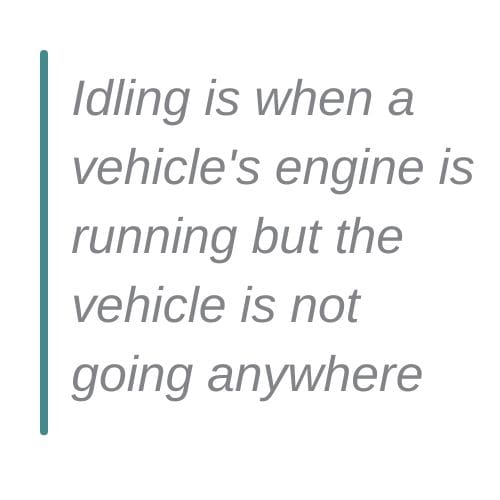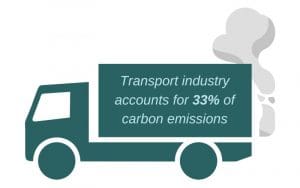
One of the most considerable costs eating into eCommerce business profits is fuel cost. On average, a delivery truck uses 1,800 gallons of gas annually, with a significant portion going to waste due to idling. A recent Office of Energy Efficiency survey reveals that 39% of fleet vehicles idle for three to four hours daily, with another 14% over four hours daily. With the ever-rising cost of fuel, it is time for fleet managers to ask the hard question, “what does idling mean to my delivery business?” This blog focuses on the cost of this behavior and the effective ways to cut down on the practice.

What Does Idling Mean?
Idling is when a vehicle’s engine is running but the vehicle is not moving. For example, a delivery truck vehicle may end up idling when stuck in a traffic jam or waiting at a red light. Idling drivers waste time and fuel, and it is also harmful to health and the environment. If you manage a delivery team, you will want to reduce this behavior whenever you can.
When Does Idling Occur?
During deliveries, idling might occur in various situations. These include:
- Loading and unloading goods: This may occur when goods are being loaded onto a truck for delivery. It may also occur when goods are being unloaded at the destination. It takes an average of an hour to load and unload a 10-foot truck. A 20-foot truck takes 3 hours, with a 24-foot truck taking about 4 hours.
- Traffic jams: Traffic jams account for the biggest idle time in delivery routes. For many fleet managers and drivers, traffic congestion on the highways and byways used by their trucks is a normal part of their day. The American Transportation Research Institute reveals traffic delays result in more than 996 million hours of lost productivity for truckers each year.
- Other times: Idling an also occur when the driver is processing paperwork, talking on the phone with someone else, or taking a rest. Other times when it is likely to occur is when the driver is warming up or cooling down the insides of the truck during summer or winter.
How Does Idling Impact Your Deliveries?
Idling is undoubtedly costly for any fleet operator. Here are some of the impacts that fleets can see:
It Drives Fuel Costs Up

Generally, fuel costs account for 60% of a fleet budget. Idling burns through fuel quickly to rack up the fuel costs used in the delivery business. A recent study reveals vehicle idling uses up an average of 0.5 gallons per hour, which varies based on the type and size of the vehicle engine. Even idling for a few minutes daily may cost you several dollars each week. A delivery truck idling for 25% of the working day wastes $2500 worth of fuel annually. This is a tidy sum of money that could come in handy in the current highly volatile business environment.
Additional Maintenance Costs
Excessive truck idling can push maintenance costs up. The American Trucking Association (ATA) reveals idling adds an extra $2,000 to truck maintenance costs and shortens the engine’s life. Generally, idling causes twice as much wear and tear on internal parts as driving at average speeds. Idling also causes more damage than stopping and starting an engine. While frequent restarting costs a meager $10 worth of wear and tear per year, idling leaves harmful fuel residues that cause engine damage. This ultimately results in higher maintenance costs over time.
Fewer Deliveries
When drivers spend too much time idling in traffic, they take longer to reach their destinations. This result in late deliveries for the businesses, which impacts the customer experience. Studies show customers with a bad delivery experience are far more likely to go elsewhere. Too much idling time also means less number of deliveries which may force you to invest in more vehicles and drivers for the same route. This is an unnecessary cost that your business can avoid by cutting idling time.
Idling Fines
To curb carbon emissions, many states have outlawed excessive idling in their jurisdiction. States such as California, Connecticut, Delaware, Maine, Maryland, New York, Massachusetts, and Nevada impose fines of up to $25,000 for truckers who break these laws. Besides, over 80 cities and counties make it illegal for vehicles to idle on their roads. Regulations generally vary, with many jurisdictions allowing a maximum of three to five minutes of idle time. Truck drivers who idle excessively may cost fleet owners and operators significantly in fines.
Environmental and Health Costs

The transport industry accounts for approximately 33% of carbon emissions. Carbon is one of the potent greenhouse gases driving global warming and climate change. The rising temperatures, fires, droughts, flooding, and severe weather due to global warming continue to impact all sectors of the economy. Apart from contributing to global warming, there are also other concerns regarding the effects of vehicle idling on drivers’ health. Increased idling reduces the quality of air that the truck driver and the entire community inhale. This may result in damaged lunges, heart disease, asthma, and other health issues for drivers.
Creates “Ghost Miles”
Truck idling creates ghost miles that reduce the value of your fleet. For every two minutes of idling, an extra mile is added to the mileage. Putting too many miles on your vehicle translates to more routine maintenance practices, which increases your maintenance budget.
Exposes Vehicle to Theft
Delivery trucks have become a target for thieves looking for goods to steal and sell. Unfortunately, many drivers leave their vehicles idling while they attend to other tasks, including processing paperwork, shopping in convenience stores, or eating at fast food joints. This way, the risk of vehicle theft increases substantially. A National Insurance Crime Bureau (NICB) report reveals about 81,911 vehicles stolen in 2018 had their keys or fobs inside. Many companies today, including ups, have policies that mandate drivers to turn off the engine and remove the keys at every delivery.
How to Decrease Idling During Delivery Routes
The following are some of the easy ways to decrease idling during delivery routes:
- Route Optimization Software: It is impossible to avoid traffic jams altogether on your delivery routes. Fortunately, advanced route optimization software can help you find the best routes for all your delivery vehicles. The right software leverages advanced algorithms to calculate the ideal route for each destination based on the unfolding scenarios. It takes into consideration all variables likely to affect shipping times, including traffic, road closures, weather conditions, and accidents. With the right software, fleet managers can quickly adjust the driver’s route when needed to avoid unnecessary idling time due to unforeseen events. The system can also provide real-time alerts that notify drivers to turn their engines off when they are stuck in traffic jams.

- Adopt Auto-Stop/Start Technology: Another effective way to cut vehicle idling time is to adopt auto-stop/start technology. The technology is designed to automatically shut the engine off once the vehicle is at a complete stop. The engine then automatically starts back when the driver taps the gas. In fleet management, start-stop systems can save fleet operators a lot of fuel costs. Industry reports reveal that start-stop technology can achieve fuel savings of up to 15%, depending on one’s driving style. It can be a great investment for fleets that frequent high-traffic routes.
- Employ GPS Tracking: A GPS tracking device helps track driver activities, giving you better insights into how they use their vehicles on the job. The system keeps a lot of hours on services, thus making it easier to spot bad habits like excessive idling. Keep in mind not all idling is due to bad driving habits. Sometimes heavy traffic jams trap drivers in a place where they can’t kill the engine to save fuel. GPS tracking devices provide crucial data on heavy traffic routes, so you reroute drivers away from clogged highways.
- Monitor Driver Behavior: Consider using tracking technologies that provide deep insights regarding how drivers behave while on the road. A good telematics system allows fleet managers have complete visibility of drivers speeding, braking, cornering, and idling. You can use the information on your systems to create training programs that target idle time reduction. The system also allows you to set alerts for drivers.

- Geofence Your Routes: Geofencing can also help reduce idling time. You can set geofences around idling hotspots, so you get alerts whenever a driver enters the perimeter. You will then contact the driver and reroute them back on track.
- Conduct Regular Training Sessions: Fleet managers should have regular training sessions to coach drivers on the cost of idling. When drivers are taught about the negative impacts of idling on the company, the environment, and their health, they will include the best practices in their daily driving experiences. Ensure guidelines for engine idling are part of your training program and safety culture. For example, make policies that mandate drivers to turn off their vehicles if there is a need to stop for a few minutes.
- Install Auxiliary Power Units: Auxiliary power units (APUs) offer cooling, heating, and electrical power. The APU motors are mounted on the side of a truck behind the sleeper cabin. Drivers can use these devices to cool or health their cabins during their rest times. This way, they will make their cabins comfortable without burning fuel. APUs are much more friendly regarding fuel consumption than the main truck engine.
FAQs
Does the engine need to warm up by idling in cold weather?
You don’t need to warm up your car unless the prevailing temperatures are below 0 degrees Fahrenheit. In fact, idling in cold weather can actually harm your engine. If you are driving in frigid temperatures, the best way to warm up your engine is to drive slowly for the first few minutes.
How long can I leave my vehicle idling?

For small vehicles, it is advisable to turn off your engine when planning to stop for longer than 10 seconds. It is a common myth that restarting your engine uses more gas and leads to more wear. For large trucks idling your car for 30 seconds to a minute is acceptable, and it will not cause any harm to your vehicle. *graphic with timer & truck
Is it better to idle in neutral or park?
It is advisable to shift your vehicle to neutral at every stop. This is because the vehicle is resting when in neutral, which reduces vehicle strain.
Can excessive idling add mileage?
Idling not only wastes fuel but also increases vehicle mileage. On average, one hour of idle time translates to 30 miles of driving.
What are the state and local regulations on truck idling?
Truck idling can harm the environment. As the world adopts measures to reduce carbon emissions, several states have enacted regulations that limit it in their jurisdictions. Today, over 28 US states and 80 cities enforce idling regulations. These laws limit idling time and impose fines for failure to comply. Civil or criminal fines range from $25,000 to $50,000, including potential time in prison.
Can idling be reduced through behavior change?
While technologies play an integral role in reducing fleet idling, direct action that targets behavior change has proven to be more effective. Some behavioral methods companies use to reduce idling include driver training, policy changes, and financial incentives.
How does GPS tracking software helps cut down the fleet’s idling time?
You can use GPS fleet tracking software to reduce your fleets’ idling time. The system allows you to get alerts whenever your driver goes outside the designated route or stays idle for too long.

Leverage the Best Route Optimization Software to Reduce Idling
Vehicle idling impacts your delivery business in various ways. Apart from increasing your fuel costs, it also damages the vehicle’s engines leading to higher maintenance costs and a shorter lifespan. If this impacts your bottom line, consider route optimization to improve your fleet efficiency.
At Elite EXTRA, we provide quality routing software with GPS tracking that shows every instance when a driver is idling for too long. You can use the platform to help find the best sequence of stops for faster deliveries and schedule various deliveries in the same region for your drivers to complete them in one go. Contact us today to learn more about our routing software.
Sources
https://afdc.energy.gov/data/10308
https://enginesoff.com/2_1_trucks.htm
https://www.transportation.gov/
https://www.cnbc.com/2022/01/14/thieves-find-new-source-for-stolen-goods-delivery-trucks-and-trains-.html
https:/www.startribune.com/idling-cars-are-invitations-for-thieves/566925812/
https://www.epa.gov
https://batteryworld.varta-automotive.com/en-be/why-a-working-start-stop-system-is-so-important-to-save-fuel







